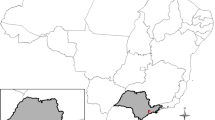Abstract
Utilization of a new geomorphometric variable for land surface segmentation — the angle of absolute curvatures — is a main goal of the paper. The angle of absolute curvatures is defined as the difference between the orientation of maximal curvature (field independent) and the orientation of the greater of the profile or the tangential curvature. Land-forms separated by three types of borders (A, B, C) can be delimited from the field of angles of absolute curvatures. Borders of A type are connected with a local extreme of slope. Borders of B and C type are connected with a change to the priority of either profile or tangential curvature, as shown in computation, respectively. Fields of altitude, slope, profile curvature, tangential curvature and rotor curvature are reflected by an algorithm. Distinct borders in the field of the angles of absolute curvatures are connected with a sudden change of value and with zero isolines in the previously mentioned fields. Spatially closed entities generated by this proposed algorithm are considered to be a variant of the elementary forms of the land surface. The quality of information generated by this algorithm depends on the size of the grid mesh of the input digital elevation model. The algorithm in its current state is suitable for locating the borders of some elementary forms in the first stage of geomorphology mapping.
Similar content being viewed by others
References
Burian L., Analysis of relationship between gravity field dependent curvatures and field independent curvatures of land surface. Master thesis, Comenius University, Bratislava, 2012 (In Slovak)
Pike R J., Evans I S., Hengl T., Geomorphometry: A brief guide, In: Hengel T., Reuter H I., Geomorphometry: concepts, software, applications, Elsevier, 2008
Pike R., A bibliography of Terrain Modelling (Geomorphometry) the Quantitative representation of Topography, Open file report, 2002, 02-465
Evans I.S, Minár J., Classification of Geomorphometric variables, 2011, http://www.geomorphometry.org/system/files/EvansMinar2011geomorphometry.pdf
Sharpy P.A., Land Surface in Gravity Points Classification by a Complete System of Curvatures, Mathematical Geology, 3,27, 1995, 373–390
Evans I.S., General geomorphometry, derivatives of altitude and descriptive statistics. In: Chorley R.J (Ed.), Spatial Analysis in Geomorphology. Harper and Row, New York, 1972, 17–90
Minár J., Evans I.S, Elementary forms for land surface segmentation: The theoretical basis of terrain analysis and geomorphological mapping, Geomorphology, 95, 2008, 236–259
Minár J., Fuzzy approach in geomorphological mapping, Geomorphologia Slovaca, 1, 2006, 8–13
Minár J., Machova Z., Review of approaches for segmentation of land surface, Geomorphologia Slovaca, 2, 2004, 74–80 (in Slovak)
Waters R. S., Morphological mapping, Geography, 1958, 43, 10–17
Savigear R. A. G., A technique of morphological mapping, Annals of the Association of American Geographers, 1965, 55, 514–538
Dalrymple J.B., et al., An hypothetical nine unit landsurface model, Zeitschrift f"ur Geomorphologie, 1968, 12, 60–76
Conacher A. J., dalrymple J. B. The nine-unit ladsurface model: An approach to pedogeomorphic research, Geoderma, 18, 1977, 1–154
Young A., Slopes, Oliver & Boyd, Edinburgh, 1972
Lastoczkin A. N., Morphodynamical analysis, Nedra, Leningrad, 1987 (in Russian)
Lastoczkin A. N., Surface of land surface (Statistical methods and approaches in geomorphology), Nedra, Leningrad, 1991 (in Russian)
Minár J., The principles of the elementary geomorphological regionalization, Acta Facultatis Rerum Naturalium Universitatis Comenianae, 1992, 33, 185–198
Minár J., et al., Geoecological research and mapping in large scales. In: Geograficke spektrum 3, Geografika, Bratislava, 2001 (in Slovak)
Speight J. G., A parametric approach to landform regions. In: Brown E.H., Waters R.S. (Eds.), Progress in Geomorphology: Papers in Honour of David L. Linton, Alden Press, London, 1974, 213–230
Brandli M., Hierarchical models for the definition and extraction of terrain features. In: Burrough, P.A., Frank A.U. (Eds.), Geographic Objects with Indeterminate Boundaries, Taylor & Francis, London, 1996, 257–270
Irvin B. J., et al., Fuzzy and isodata classification of landform elements for digital terrain data in Pleasant Valley, Wisconsin, Geoderma, 77, 1997, 137–154
Dragut E., Eisank C. Automated object-based classification of topography from SRTM data, Geomorphology, 141–142, 2012, 21–33
Richter H., Eine neue Methode der grossmassstabigen Kartierung des Reliefs, Gotha, 106, 1962, 309–312
Troeh F. R., Landforms equations fitted to contour maps. American Journal of Science, 263, 1965, 616–627
Krcho J., State of czechoslovak cartographic science and the problem of thematical maps, Acta geologica et geographica, 3, 1963, 204–215 (in Slovak)
Krcho J., Morphometric analysis of relief on the basis of geometric aspect of field theory. Acta geographica Universitatis Comenianae, 1, 1973, 1–233
Krcho J., Morphometrical analysis and digital elevation models, VEDA, Bratislava, 1990 (in Slovak)
Gauss C.F., Disquisitiones generales circa superficies curvas, Comentationes Societatis Regiae Scientiarum Gottingensis Recentiores, 9,99, 1928, 146
Efremov Y.K., An experience on morphological classification of elements and simple forms of topography. Voprosy Geografii, 11,109, 1949, 136 (in Russian).
Sharpy P. A., Topographic method of second derivatives. In: Stepanov, I.N. (Ed.), The Geometry of Earth Surface Structures, Poushchino Scientific Center, Poushchino, 1991, 28–58 (in Russian)
Parson A J., Hillslope Form, Routledge, London, 1988
Goodchild M. F. Spatial Autocorelation, Geo Books, Norwich, 1986
Author information
Authors and Affiliations
Corresponding author
About this article
Cite this article
Burian, L., Minár, J. Utilization of a comparison of curvatures for land surface segmentation. cent.eur.j.geo. 5, 560–569 (2013). https://doi.org/10.2478/s13533-012-0143-6
Published:
Issue Date:
DOI: https://doi.org/10.2478/s13533-012-0143-6




